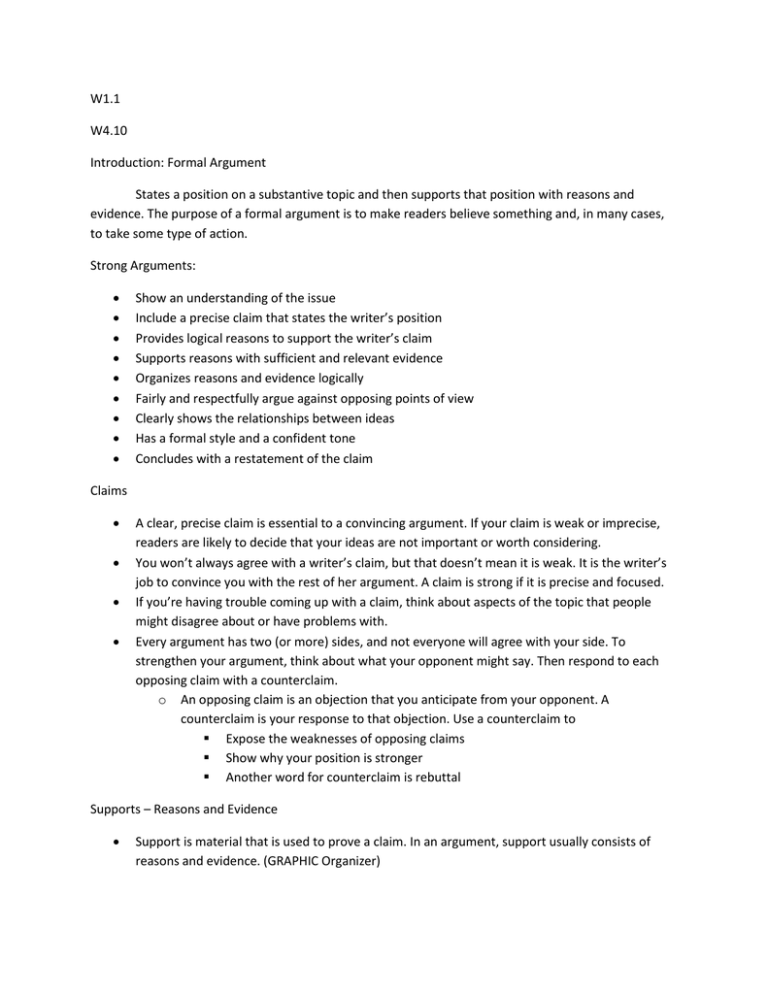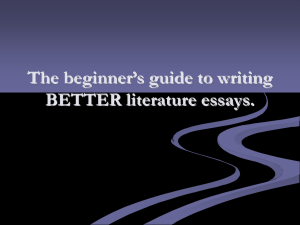Argument Notes - Everglades High School
advertisement

W1.1 W4.10 Introduction: Formal Argument States a position on a substantive topic and then supports that position with reasons and evidence. The purpose of a formal argument is to make readers believe something and, in many cases, to take some type of action. Strong Arguments: Show an understanding of the issue Include a precise claim that states the writer’s position Provides logical reasons to support the writer’s claim Supports reasons with sufficient and relevant evidence Organizes reasons and evidence logically Fairly and respectfully argue against opposing points of view Clearly shows the relationships between ideas Has a formal style and a confident tone Concludes with a restatement of the claim Claims A clear, precise claim is essential to a convincing argument. If your claim is weak or imprecise, readers are likely to decide that your ideas are not important or worth considering. You won’t always agree with a writer’s claim, but that doesn’t mean it is weak. It is the writer’s job to convince you with the rest of her argument. A claim is strong if it is precise and focused. If you’re having trouble coming up with a claim, think about aspects of the topic that people might disagree about or have problems with. Every argument has two (or more) sides, and not everyone will agree with your side. To strengthen your argument, think about what your opponent might say. Then respond to each opposing claim with a counterclaim. o An opposing claim is an objection that you anticipate from your opponent. A counterclaim is your response to that objection. Use a counterclaim to Expose the weaknesses of opposing claims Show why your position is stronger Another word for counterclaim is rebuttal Supports – Reasons and Evidence Support is material that is used to prove a claim. In an argument, support usually consists of reasons and evidence. (GRAPHIC Organizer) To come up with reasons, turn a claim into questions. Your answers are reasons you can use as support. Types of Evidence o Facts o Examples o Statistics o Quotations o Anecdotes o Although each piece of evidence supports s specific reason, all of the evidence should clearly relate to the writer’s position or claim. The evidence must also come from credible, reliable sources. A well-constructed argument may include more than one reason in support of the claim and counterclaim, and it may include more than one piece of evidence for each reason. (s/b at least 2) Building Effective Support For your argument to be strong, you must support your claim with reasons and evidence that are o Logical: the reasons make sense as support for your claim o Relevant: the evidence is appropriate and related to the reason it supports. o Sufficient: there is enough evidence to prove your point o Tailored to the audience: the reasons and evidence reflect the audience’s knowledge level and concerns. o When choosing support, always keep your readers in mind. The last think you want is for them to think “who cares?” ‘so what?’ or ‘This doesn’t apply to me.’ Identifying Logical Reasons – a logical reason clearly relates to the claim (or counterclaim) and strongly supports the writer’s point of view. Your argument will be most convincing if you vary the types of evidence you use to support each reason. o Remember that when you write an argument, you can use any of these types of evidence to support your reasons: Facts that can be verified Specific examples Accurate statistics Quotations, especially from experts Compelling anecdotes When people are passionate about an idea, they may resort to ineffective strategies to prove their point. Instead of being convincing, these strategies can turn an audience off. A logical fallacy is a statement that is given as support but that is really an error in reasoning, A writer may do this intentionally to mislead his or her audience, or the writer may simply make an error in judgment. At first glance a logical fallacy may appear to make sense, but on a closer examination it does not. Writers sometimes make unreasonable or unfair statements when presenting an opposing point of view. Remember that in a balanced argument, opposing points of view are presented fairly and respectfully. Logical fallacies include: o Circular reasoning is restating an opinion or conclusion in different words in an attempt to pass it off as a reason or evidence. o Hasty generalizations are statements that are too broad to be accurate. They are untrue, do not apply in all cases, or lack evidence. o Either/or fallacy provides only two possible choices or outcomes of a situation while ignoring other valid choices or outcomes. o False cause and effect incorrectly states that one event has caused another. The events may seem to be related, but the relationship is not one of cause and effect. o Commonplace assertions are statements that many people say as if they are true but that are not necessarily backed up by facts. Most commonplace assertions are generalizations about life or human nature. o Loaded Language consists of words with strongly positive or negative connotations that are intended to influence a reader’s attitude. Know your audience – questions to ask… o Who is my audience? o Are they older than I am? Younger? The same age? o What do they already know about my topic? o What interest have they shown in my topic? o Why should my topic be important to them? o Do they have personal or professional experience with my topic? o What parts of my argument might they question? o What do I want them to understand? o If my audience accepts my point of view, how will it affect them? o Use your audience profile to choose the evidence most likely to convince your readers to accept your claim. Creating Coherent Arguments When developing an argument, make sure your ideas go together in a way that your audience can follow. A coherent argument hangs together. That means that all the words, sentences, and paragraphs come together to form a unified whole. It’s not magic; certain techniques help you achieve cohesion. In a coherent argument, ideas are organized in a logical sequence. o Order of importance (from least important to most importanta; from most important to least important) o Order of complexity or length o Order of familiarity o Order of likely acceptance Pronouns are words that stand in for nouns, and synonyms are words with similar meanings. Writers use pronouns and synonyms to connect ideas and avoid repetition that might resulting in dull, awkward-sounding text. Repeat key words and phrases. Sometimes writers intentionally use repetition to emphasize and important concept, connect related ideas, establish a rhythm, and create cohesion. Use clear and varied syntax o Syntax refers to sentence structure, or the way words are arranged in sentences, by varying syntax, writers create unity and add interest. Use transitional words and phrases. o Transitional words and phrases link ideas, sentences, and paragraphs. For your argument to be coherent, each piece of evidence must clearly relate to the reason it supports and to the other sentences in the paragraph. To make your argument flow seamlessly, try varying your word choice and syntax (sentence structures): o Use pronouns and synonyms to connect ideas and aboid unnecessary or boring repletion. o Use a variety of sentence patterns. For example, instead of a simple subject-verb arrangement, try beginning a sentence with an introductory word, phrase, or clause. For more variety, you might also use a combination of simple, compound, complex, and compound-complex sentences. o TIP: After revising a paragraph, read it out loud. If you find yourself stumbling as your read, you’ll know that the paragraph still isn’t coherent. Go back and try again until it reads smoothly. Persuasive Techniques o o o o Pitfalls of Persuasion – Writers use persuasive techniques to tap into the desires, feelings, and values of their audience. When used responsibly, these techniques really work! Sometimes though, writers go overboard or use these techniques without supporting evidence. They try to mislead and deceive readers. A savvy audience isn’t fooled that easily. Readers can spot misleading and deceptive persuasive techniques. So make sure you understand how these techniques work, and always use them responsibly and thoughtfully. What are persuasive techniques? o Note: it is important to remember that persuasive techniques alone are not enough to convince readers to accept your claim. You must provide strong reasons and relevant evidence to argue effectively. o Word Choice – includes Loaded language: words with strong positive or negative connotations (also known as associations) o o o o Glittering generalities: the use of strongly positive but vague language; these words tend to sparkly and glitter. But don’t really say much. When writers feel strongly about an issue, they may use loaded language and unintentionally weaken their claim. Emotional appeals – include the use of words or images intended to generate feelings of fear, pity, or vanity. Emotional appeals can be very effective, but they frequently cover up faulty logic. Ethical appeals link specific claims to commonly held beliefs or causes, such as duty, justice, or a sense of what’s right Appeals by association include bandwagon (plays on reader’s need to be “one of the gru”); testimonial *uses celebrities or experts to support an idea, a cause, or a Snob appeal (takes advantage of the audience’s desire to be part of an elite group; transfer (connects a product, candidate, or cause with a positive emotion or idea); and appeal to loyalty (plays on readers’ desire to display loyalty to a specific group. Formal Style o o o o Experienced writers think about their audience and purpose for writing before they begin. They choose a style that suits their readers and their task: Authors of academic and published writing, such as textbooks, newspaper and encyclopedia articles, government and corporate websites and blogs, letters to the editor, an business correspondence tend to use f formal style. Friends and colleagues tend to write informally in personal blogs, emails, or text. Elements of formal style o Avoid contractions – contractions are fine to use in everyday speech, but in formal writing you should spell out contractions. o Ask yourself these questions to determine if a writer’s style is formal and his or her tone is objective. Does the writer …..? Spell out contractions Avoid addressing the reader as you Follow the conventions of standard English Avoid slang and colloquial or everyday language Show respect for the reader Concluding Your Argument o Make a strong conclusion the writer takes one last opportunity to convince reads to agree with his or her point of view. Make the best of your last chance! Include these elements when you write a conclusion. o Is a logical follow-up to ideas presented in body paragraphs. o Restates the claim and its significance o When appropriate includes a call to action to believe in something or to do something. o If necessary, ties up any loose ends o o May point out a new, interesting idea closely related to the claim that leaves readers with something to think about (without going off on a tangent)





